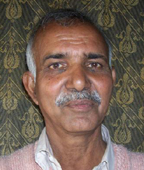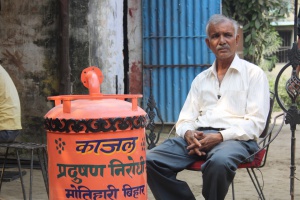Name : Virendra Kumar Sinha
District & State : East Champaran, Bihar
Category : Ecofriendly Green/Energy conservation
Award : National
Award Function : 5th National Grassroots Innovation Awards
Award Year : 2009
Innovation Description
- IPR Status
“Mehnat kijiye, achha rahiye. Parishram hi sabkuchh hai. Imandari se rahiye, pehle dikkatein to aayengi parantu safalata avashya milegi agar nischay dridh hai to”
 (Hard work is everything. Be honest, initially there would be problems but success will eventually come if there is a firm desire to succeed)
(Hard work is everything. Be honest, initially there would be problems but success will eventually come if there is a firm desire to succeed)
There are absolutely no generators/gensets in the country that have a pollution control device attached to them. Even, there is no requirement for the same under the present rules. However, Virendra Kumar Sinha (58), a self-taught welder and fabricator, has made a pollution control device for gensets. This attachment precipitates the suspended particulates present in the exhaust gases making it clear along with reducing its temperature.
From a Playful Childhood to a Struggling Career
Born in a middle class family in 1950, Virendra is the eldest of six siblings- two brothers and four sisters. Unlike his siblings, he was never interested in studies. But, being the eldest, he was not scolded and was in fact quite pampered. Apart from football and marbles, he would often play with wires and electrical gadgets. He was always restless and inquisitive. Growing up, he started repairing sewing machines, air pumps, bicycles etc. for the family and neighbours as well. Though his siblings continued their studies, he could not clear the class 12 exams and took admission in an ITI course. However, he had to leave it midway to attend to his family duties. He started his career as a road and building contractor in early seventies. Thereafter, he started cloth export to earn more but soon had to close down, as it also did not fetch him a steady income.
Pondering over various options, he decided to assist his friend in his fabrication workshop. Gaining exposure in the field for close to a year and a half, in the early eighties, he decided to move on to set up his own fabrication unit for manufacturing iron gates and grill works with a small loan from a bank. Struggling initially in the first six-seven months, he started networking with the local hardware storekeepers to get orders. He recounts that during this period his deceased friend Bachchubhai was a great support, as he always encouraged him to persevere. His workshop was in Motihari town, but with low income and high rent, he had to shift to his house in Belwana village, two kilometers away from it.
His fabrication unit, Kaajal steel, named after his elder daughter, made slow but steady progress over the next twelve-thirteen years. But around 1994, a difficult phase started when his firm had to face fierce competition from other workshops. To keep himself in the competition, he started innovating designs for gates and grills and kept their prices close to the older ones. Also, to maximize returns, he retained more skilled workers and increased their wages, relieving the rest. Gradually, things improved and today he is in a much comfortable position.
Staying afloat
Just opposite to a school, Virendra operated his fabricating workshop in his home, in a congested colony. He used a diesel genset (generator coupled with stationary engine) as an alternative to the erratic electricity supply. The problem was that the genset made a lot of noise, released considerable smoke causing pollution and also disturbed the children. But neither the school nor the workshop could be moved away.
Virendra had to face hostile neighbors who went to court over the high decibel noise and pollution from the generator used in his fabricating unit. The SDM and court authorities also asked him to either solve the problem or close down his unit. With his limited resources, he could not relocate the unit. Resolving to settle the issue once and for all, he thought about designing an attachment that would drastically minimize the noise as well as the smoke. While pondering on how to build the device, he remembered the science teacher of his school mentioning- “When we make a noise in a closed room, its effect on the people outside is much less than when we make same amount of noise in open public space”.
He then decided to experiment and build a special chamber to muffle the sound and break down the exhaust components. Using commonly available materials such as an iron drum, perforated iron pipes, steel channels, baffles and soot collecting tray, Virendra built the first prototype with multiple muffling chambers. It cost him Rs. 4000. This unit was fitted to the 10 HP engine being used in his workshop. This resulted in considerable noise reduction. Over a period of eight months, he continued to invest and experiment and finally made a device that reduced the noise further. So much so that some of his neighbours even came to inquire if all was well in his workshop. The emission also reduced but not to his satisfaction. He continued to improvise and after for about a decade gave the machine its present shape, which matched the level of perfection he was looking for.
Apart from his compassion towards the children and the environment, the court judgment against him in response to the protest by neighbours also led him to develop this device,
